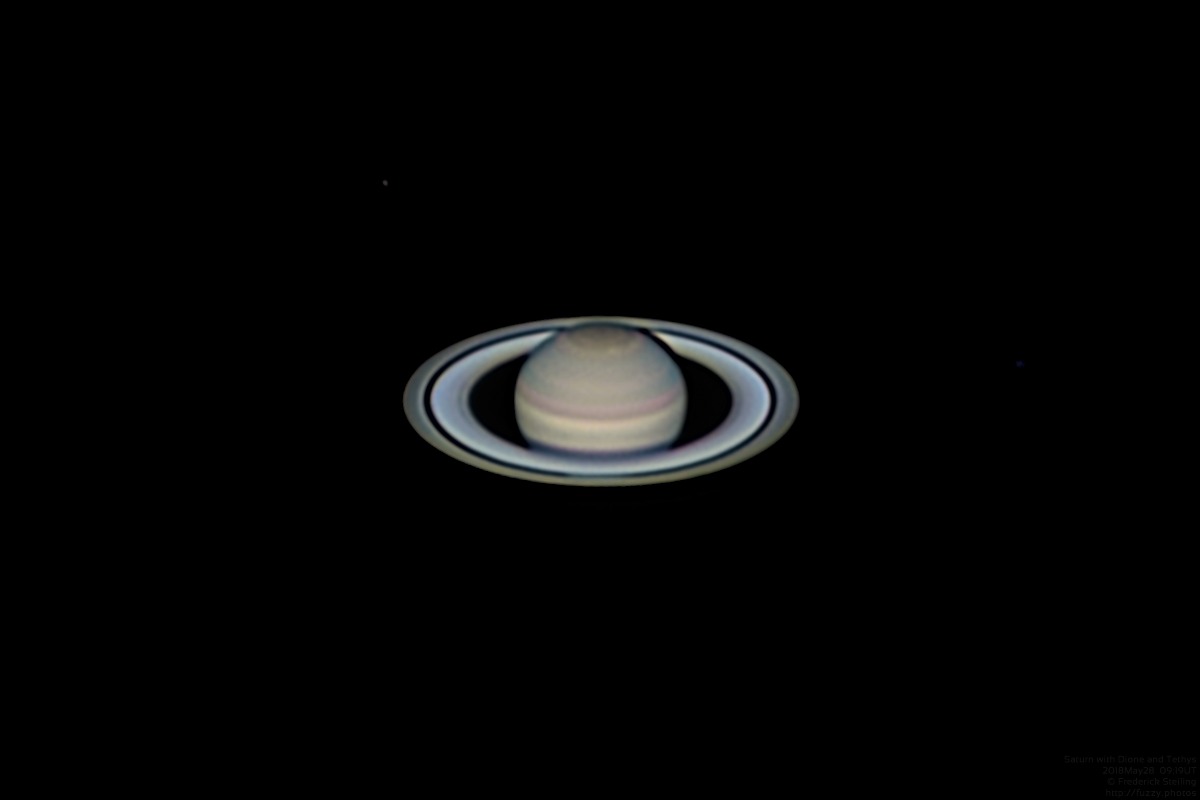| Image Links | |
| Published image | Full resolution |
| Annotated image | Full resolution |
| Red Filter Video | Via YouTube |
| Target Information | |
| Main Target Designation(s) | Saturn |
| Companion Object(s) | Dione, Tethys |
| All Exposures | |
| Date(s) of acquisition | 2018May28 at 09:19UT |
| Location | Defiance, MO |
| Capture resolution | 640x480 |
| Target Altitude | 27.0° |
| Red Exposures (also as Luminance) | |
| Total capture | 1591 x 56.55ms at 75% gain |
| Stack source | 40% of 90" video at 17 fps (avg) |
| Green Exposures | |
| Total capture | 1197 x 75.21ms at 75% gain |
| Stack source | 40% of 90" video at 13 fps (avg) |
| Blue Exposures | |
| Total capture | 1122 x 80.18ms at 75% gain |
| Stack source | 25% of 90" video at 12 fps (avg) |
| Equipment | |
| Imager | ZWO ASI174MM |
| Filters | ZWO 1.25" RGB |
| Telescope/Lens | Celestron C14 XLT SCT |
| Magnifiers | Tele Vue 2x Powermate |
| Effective Focal Length | 7820mm (f/22) |
| Mount | Celestron CGE Pro |
| Focuser | Moonlite 2.5" CSL |
| Software | |
| Acquisition | FireCapture 2.5 |
| Guiding | None |
| Processing | AutoStakkert 3, Registax 6, WinJUPOS 10, PixInsight 1.8 |
In a continuing effort to improve the data available from ASEM's C14 telescope at Broemmelsiek Astronomy Park using some new gear that includes an ASI174MM planetary camera, I acquired this RGB data set on Saturn through very mediocre skies. The result is astounding and encouraging!
After a series of nights tweaking and improving collimation with star tests and analysis using Metaguide, it seemed reasonable to point the scope at Saturn after earlier acquiring as-yet unprocessed data on Mars and Jupiter. With Saturn only at 27° in altitude, there was a lot of atmosphere between us and it. But, with solid collimation and camera alignment, passes of sharpening in Registax and PixInsight gave excellent results here that expose not only the famous "hexagon" at the northern pole, but also the moons Dione (10.63 magnitude) and Tethys (10.43 magnitude) that presented as blips of signal that were carefully exposed from the RGB data.
The skies overall were not very good, with fog, hazy clouds, and poor seeing all present. However, as I'm starting a separate program to observe the 2018 Mars apparition over the course of several months, this data makes me confident that I'll have plenty of "good enough" skies to acquire the necessary data to observe a variety of Martian features throughout the year.
Next up we have a ZWO Atmospheric Dispersion Corrector on its way for testing and incorporation into the imaging train. If it works as advertised, we look to have even better data on the way this year!

